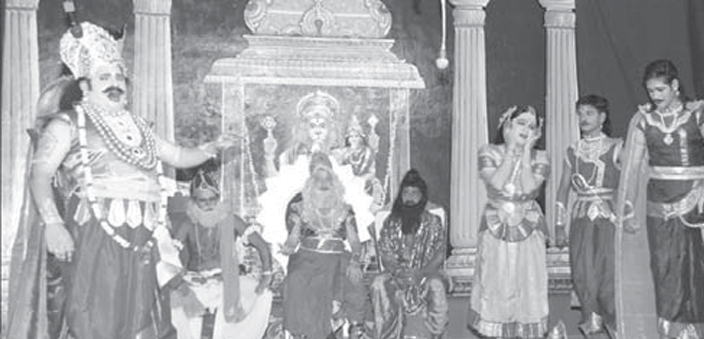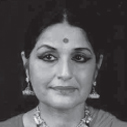Folk theatre is the theatre which originated and evolved among the common people. Its relationship with the common people is deep, multiple and multi-layered. It is a kind of entertainment which is not entertainment alone. It carries within it the entire folk culture with all its social and religious institutions. We find reflected in folk theatre the cults, customs, rituals and beliefs of common people. Sometimes it takes the form of a ritual performed to propitiate divine forces for the welfare of the society, and sometimes it is entertainment, pure and simple. It is a part of his tradition with which he has lived for generations.
Folk theatre encompasses theentire gamut of performing arts, including art forms like magic, acrobatics, martial arts or any other device it deems useful. Often this theatre, vast in scope, does not remain confined to a small stage, but converts the entire locality into a theatre. Action flows from people and their environment to the performing arena, and from there back to the source in a single sweep.
The tradition of Indian folk theatre reaches back to distant antiquity. It comes down to us from the aboriginal cave-man who has left a record of his theatrical activities in the form of sketches and paintings on the walls of his abode. Ancient Vedic literature, Buddhist literature, works like Arthashastra tell us about the enchanting panorama of Indian folk theatre.
Historically speaking, it was during the 15-16th century that the folk theatre emerged forcefully in different regions. It used different languages, the languages of the regions in which it emerged. We are basically concerned here with these forms of folk theatre.
The Vidushaka and the Sutradhar and the roles they play
The Vidushaka (jester) as a ‘simpleton whose imbecility, real or assumed, is utilised for entertainment’, appears in folk theatre in various forms and under different names. He is very dear to village audiences. He is a shrewd person with wide experience and keen observation under the garb of simplicity. All through his evolution, he never lost contact with contemporary life. He has shown tremendous capacity to change with the times and remain eternally fresh. Like his counterpart in classical theatre, he is not bound by a ‘written script’ or ‘set rules of behavior and appearance’; he is free and flexible enough to adapt to changing sensibilities, to acquire new traits.
Yet another figure which dominates the folk theatre is the Sutradhara. In the Indian folk theatre, Sutradhara, who is known by different names in the different regional varieties, holds the most important position in the entire scheme of the play. In a way, he may be called the focal point of the evolution of folk theatre itself. In folk theatre, the narrator, the Sutradhara, became an excellent device for translating any story into a coherent dramatic production. He is the person who explains the story or relates the story with the help of the actors. Though the narrator-Sutradhara delegated some of his functions to actors and musicians, he retained his important position as a presenter of the show and like the thread in a garland, his presence is felt throughout the performance. He conveniently recedes to the background, leaving the stage to the actors and dancers to translate his words and message into dramatic action.
Folk play is basically narrative in character with a social, religious or moral message to deliver. The Sutradhara keeps up the tone of narration of the folk play. He breaks the continuity of the play and also maintains it. His presence became essential because of one peculiar characteristic of the folk play. That is, there is hardly any written, well-defined script. Cue is provided by the narrator to the actors to improvise dialogues on the spur of the movement or sometimes a ready-made piece is given to them to translate it into dramatic action.
The Bhagavatmela of Melattur
One travels to Melattur through the lush vegetation of rice fields and coconut palms of Tamil Nadu. A stream of the River Kaveri flows nearby. The village was given as a gift by Achyuthappa Naik to the migrant Brahmin families. The Varadarajaswami temple is the centre of activity, religious and social. The Narasimhajayanti is held in May and June: this is the time of presenting the Bhagavatamela natakam.
A thatched auditorium is constructed in front of the temple: the pandal may have a length of 100-120 feet and the stage has a depth of 18-20 feet. The deity is installed in the front hall of the temple; symbolically, the performance is dedicated to the deity. As in the case of the Kutiyattam, Kathakali and Yakshagana, the performances begin at 9.30 p.m. and continue till the early hours of the morning.
The green room is an adjoining thatched hut, in which are held simple ritualistic preliminaries. The performance itself begins, unlike in the Kutiyattam and Yakshagana, with the entry of the Konangi or the Vidushaka on a bare stage, even without musicians. He dances for a few minutes, speaks to the audience in prose, and then leaves. The musicians appear next in a group and sing the Todayamanglam. The word Todayam as invocation is common to the Kathakali and the Bhagavatamela traditions. The Todayamangalam of the Bhagavatamela, however, is strictly a musical composition and there is no dancing: it consists of poetic passages or svaras and pure mnemonic rhythm syllables, the sollukattus. This is followed by the appearance on the stage of a young boy with the mask of Ganesha. He dances for a few minutes to the singing of an invocatory verse on Ganesha which seeks the blessings of the deity. Though we have also observed this preliminary in the context of the Karnataka Yakshagana there is an important difference: in the latter it is often performed in the green room or behind the curtain and not necessarily in full view of the audience.
The performance begins with the entry of the chief characters. The Ganesha vandana and the introduction of the character through abstract movements seem to be common features of many dance-drama forms all over India.
Unlike the Karnataka Yakshagana, most of the singing is done by the actors themselves and not by the accompanying musicians or the Bhagavatars. The actor naturally has to be a polyvalent artist who must speak, recite, sing and dance. The orchestra comprises of a nattuvanar whose role is important, but not quite as crucial as that of the Bhagavatar in Yakshagana: he is nevertheless the chief conductor and director of the performance and guides both the musicians and the dancer. There are then the vocalists, a mridanga player and either a flute or, of late, a violin player.
The dance content closely resembles the Bharatanatyam technique of movement. The ardhamandali or the ukkaramandali is observed strictly, although it is not quite as clearly defined as by the women dancers.
There is a body of adavu patterns which include all the varieties. The same taut position of the upper torso and the triangular position of the lower limbs is maintained in all dance sequences.
The head movement, particularly the sundari (the lateral movement), is used frequently and the arms are held out as in Bharatanatyam and are used in straight lines and triangles, and never in curves. The three kaalas (speed) are used in the pure rhythmic passages and the tiramanam ends in araddhis as in Bharatanatyam. Attention has already been drawn to the abhinaya technique which also closely resembles the Bharatanatyam technique of a line to line and word to word synchronisation of word and gesture. The Yakshagana of Karnataka follows a freer and less stylised system in this sphere.
The costuming of Bhagavatamela is vastly different from anything witnessed in the Karnataka Yakshagana. Although the male characters are dressed grandiosely with much tinsel and brocade, they are realistic and there is no attempt at stylisation as in the Kathakali and the Karnataka Yakshagana.
The young boys who play the role of women stri-vesha, dress much in the style of the Bharatanatyam dancer, although some appear in saris as worn in everyday life. The makeup is of the simplest naturalistic type despite the use of large moustaches for demoniac types and none for heroes.
Conventions of make-up are minimal except for the mythical characters like Narasimhavatara, Hiranyakashipu, etc., and others where both masks and make-up are used.


